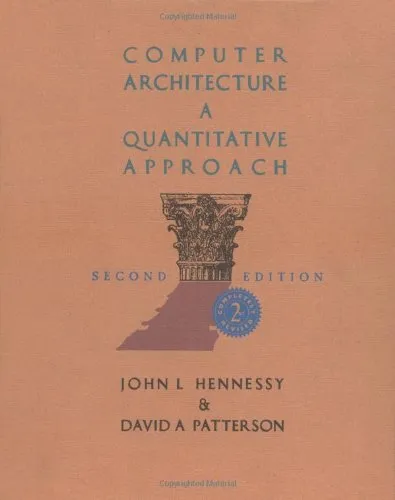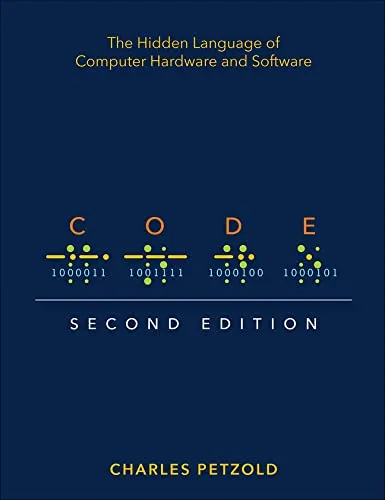Computer Architecture: A Quantitative Approach, 2nd Edition, 1996
4.5
بر اساس نظر کاربران

شما میتونید سوالاتتون در باره کتاب رو از هوش مصنوعیش بعد از ورود بپرسید
هر دانلود یا پرسش از هوش مصنوعی 2 امتیاز لازم دارد، برای بدست آوردن امتیاز رایگان، به صفحه ی راهنمای امتیازات سر بزنید و یک سری کار ارزشمند انجام بدینکتاب های مرتبط:
معرفی کتاب 'Computer Architecture: A Quantitative Approach, 2nd Edition, 1996'
کتاب 'Computer Architecture: A Quantitative Approach' اثری برجسته و ارزنده در زمینه معماری کامپیوتر است که توسط John L. Hennessy و David Goldberg نگاشته شده است. چاپ دوم این کتاب در سال 1996 به چاپ رسید و تاثیری بسیار شایان در حوزه آموزش و درک عمیق معماری کامپیوتر داشته است.
خلاصهای جامع از کتاب
این کتاب به بررسی جامع و کمی معماری کامپیوتر میپردازد و به ویژه بر روی معیارهای Performance و کارایی سیستمهای کامپیوتری تمرکز دارد. نویسندگان با ارائه مدلی ساختاری و راهنماییهای دقیق، به تحلیل و طراحی سیستمهای کامپیوتری میپردازند. تقسیمبندی مطالب به همراه ارائه مثالهای کاربردی و مشکلات واقعی، به خواننده کمک میکند تا به درک عمیقتری از عملکرد مناطق مختلف یک سیستم کامپیوتری نائل شود. مباحث کتاب شامل اصول پایهای، طراحی Processor، Memory Hierarchy، و بحث در رابطه با Input/Output و انتقال دادهها میباشد.
نکات کلیدی
- اهمیت عملکرد در طراحی معماری کامپیوتر
- نقش تحلیل کمی در بهبود کارایی سیستمها
- تکنیکهای پیشرفته برای بهینه سازی Cache و Memory Hierarchies
- رویکردهای نوین در طراحی Processor و اجرای دستورالعملها
نقل قولهای معروف از کتاب
"معماری کامپیوتر هنر یافتن توازنی بین الزامات سختافزاری و نرمافزاری است تا بتوان عملکرد بهینه را در سیستمها تضمین کرد."
"ارزیابی و تحلیل سیستمها به وسیله معیارهای کمی، پایه و اساس طراحی کارآمد در معماری کامپیوتر است."
چرا این کتاب اهمیت دارد؟
کتاب 'Computer Architecture: A Quantitative Approach' نه تنها به عنوان یک مرجع تحصیلی در دانشگاههای سراسر جهان مورد استفاده قرار میگیرد، بلکه ابزاری قدرتمند برای متخصصان این حوزه است تا دانش خود را بهروز نگه داشته و تکنیکهای نوین را در پروژههای خود به کار گیرند. این اثر با تمرکز بر روشهای ارزیابی و بهبود عملکرد سیستمها، به مهندسان و طراحان کامپیوتر کمک میکند تا چالشهای پیچیده را با روشی سیستماتیک و علمی حل کنند.
با پیشرفت روزافزون تکنولوژی، نیاز به سیستمهایی با کارایی بالاتر بیشتر احساس میشود و در این راه، این کتاب همچنان به عنوان راهنمایی بیبدیل محسوب میشود. علاوه بر این، تکنیکهای پیشنهادی در کتاب به نحوی طراحی شدهاند که خواننده را قادر میسازد تا با اتخاذ رویکردهای علمی، تأثیر نوآوریهای خود را در دنیای واقعی مشاهده کند.
Welcome to the comprehensive introduction to "Computer Architecture: A Quantitative Approach, 2nd Edition," authored by John L. Hennessy and David A. Patterson. This book is a seminal piece in the field of computer architecture, offering a solid foundation and thorough understanding of the principles that underpin the design and analysis of modern computer systems. Below, we explore various aspects and highlights of the book to give you a deep insight into what makes this edition a crucial component of any computer engineer's library.
Detailed Summary of the Book
Published in 1996, the "Computer Architecture: A Quantitative Approach, 2nd Edition" stands out as a cornerstone in computer engineering literature. The book bridges the gap between theoretical concepts and practical applications in computer architecture, focusing on a quantitative approach to design and analysis. The second edition introduced new and enhanced content on a variety of topics, including instruction set architectures, pipelining, memory hierarchies, and multiprocessors. It emphasizes performance issues and includes various performance analysis exercises accompanied by contemporary case studies. By integrating real-world examples, the authors successfully demonstrate the relevance and application of architecture principles in modern computer design.
Key Takeaways
- Quantitative Analysis: The book is lauded for its focus on quantitative assessments, enabling readers to grasp the framework required for measuring and analyzing computer architectures. The metrics provided are crucial for evaluating system performance and design alternatives.
- In-Depth Case Studies: Practical case studies provide context and contrast for the theoretical material presented. This helps solidify understanding and showcases real-world application of the concepts.
- Pipelining and Parallelism: The text delves into detailed discussions on improving processor performance through pipelining and parallel execution.
These essential techniques help understand how modern processors can execute multiple instructions per cycle. - Memory Hierarchies: By examining various memory hierarchy designs, the book provides insights into effectively managing trade-offs between speed, cost, and capacity in memory systems.
Famous Quotes from the Book
"The purpose of quantitative design techniques and the design of experiments is to provide a basis for decision making: measuring which alternative best meets the cost, performance, and power constraints of the system under design."
"Our goal is to enable the reader to design systems that can benefit from improvements in technology, changes in applications, and variations in the unpredictable costs and characteristics of technology."
Why This Book Matters
The relevance of "Computer Architecture: A Quantitative Approach" cannot be overstated. Its structured approach to complex topics renders it invaluable to students, academics, and professionals in computer engineering. The book plays an essential role in shaping a reader's understanding of the core principles driving efficient computer systems design. Since its publication, it has been adopted into curricula worldwide, proving its utility in both introductory and advanced courses. By staying at the forefront of technological advancements, the authors ensure readers emerge with applicable knowledge to tackle the challenges posed by the rapid evolution of computing technologies. This second edition, in particular, bridges past and emerging technologies, making it an essential read for comprehending the landscape of modern computing.
دانلود رایگان مستقیم
You Can Download this book after Login
دسترسی به کتابها از طریق پلتفرمهای قانونی و کتابخانههای عمومی نه تنها از حقوق نویسندگان و ناشران حمایت میکند، بلکه به پایداری فرهنگ کتابخوانی نیز کمک میرساند. پیش از دانلود، لحظهای به بررسی این گزینهها فکر کنید.
این کتاب رو در پلتفرم های دیگه ببینید
WorldCat به شما کمک میکنه تا کتاب ها رو در کتابخانه های سراسر دنیا پیدا کنید
امتیازها، نظرات تخصصی و صحبت ها درباره کتاب را در Goodreads ببینید
کتابهای کمیاب یا دست دوم را در AbeBooks پیدا کنید و بخرید



